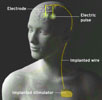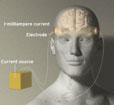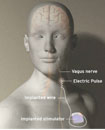

clinical research
|
|
|
Depression
Deep Brain Stimulation (DBS)
 Small electrodes are
implanted into the brain to stimulate regions that are too deep to
reach by stimulating the scalp. DBS is already approved for the
treatment of Parkinson’s disease, and is under study for the treatment
of severe and treatment resistant OCD and major depression.
Small electrodes are
implanted into the brain to stimulate regions that are too deep to
reach by stimulating the scalp. DBS is already approved for the
treatment of Parkinson’s disease, and is under study for the treatment
of severe and treatment resistant OCD and major depression.
- Current Status
- Recently published work supported antidepressant efficacy of DBS. More controlled work in larger sample sizes will be important to establishing the potential clinical role of DBS, but early results are quite encouraging.
- Principal Investigator
- Sarah Lisanby
Electroconvulsive Therapy (ECT)
ECT has been modernized substantially since it was first introduced some 70 years ago. ECT remains the most effective and rapidly acting treatment for severe medication resistant depression and other disorders. While ECT is the “gold standard,” current research is pushing the envelope to create a new standard, one that does not carry the same side effect burden as ECT. While ECT has already come a long way, the ECT of the future may be very different from the ECT of today. It will likely be performed more focally and precisely. We may use entirely new ways of inducing the seizure, with different types of electricity or with magnetic fields (see MST above).
- Current Status
- Recent research is innovating safer forms of ECT (dose titrated to the seizure threshold, right unilateral, ultrabrief pulse, focal induction). The value of these innovations will need to be established with controlled trials, and then these innovations will need to be implemented into clinical practice through national guidelines and educational initiatives.
- Principal Investigator
- Sarah Lisanby
Magnetic Seizure Therapy (MST)
 MST uses TMS (see below) to perform a more
focused form of convulsive therapy. ECT is highly effective but
carries a risk of serious side effects such as amnesia or memory
loss. MST takes advantage of the fact that magnetic fields can be
focused. MST targets the stimulation in the prefrontal cortex (a
region of the brain thought to be critical for antidepressant
response), and limits the degree to which it spreads to the hippocampus
(a region of the brain important for memory). MST holds the
promise of retaining the efficacy of ECT, but without its side effect
burden. If MST is proven effective, it could represent a breakthrough
in the way that our most severe psychiatric disorders are treated.
MST uses TMS (see below) to perform a more
focused form of convulsive therapy. ECT is highly effective but
carries a risk of serious side effects such as amnesia or memory
loss. MST takes advantage of the fact that magnetic fields can be
focused. MST targets the stimulation in the prefrontal cortex (a
region of the brain thought to be critical for antidepressant
response), and limits the degree to which it spreads to the hippocampus
(a region of the brain important for memory). MST holds the
promise of retaining the efficacy of ECT, but without its side effect
burden. If MST is proven effective, it could represent a breakthrough
in the way that our most severe psychiatric disorders are treated.
- Current Status
- MST was developed in the CU/NYSPI Department of Psychiatry. This work is motivated by the conviction that people with severe depression should not have to accept memory loss as a necessary consequence of effective treatment. MST is at the phase of initial clinical testing and we are hopeful that with the necessary support, it will reach the phase of clinical application within 5-10 years.
- Principal Investigator
- Sarah Lisanby
Transcranial Direct-Current Stimulation (TDCS)
 Early studies in Britain, in the 1960's,
suggested that transcranial direct current stimulation might be
effective in treating depression. Recent studies on small groups
of patients suffering from depression showed promising results.
Early studies in Britain, in the 1960's,
suggested that transcranial direct current stimulation might be
effective in treating depression. Recent studies on small groups
of patients suffering from depression showed promising results.
This blinded, sham-controlled, cross over trial builds upon these recent studies in extending the period of stimulation with tDCS from two weeks to possibly four weeks. If successful, tDCS could represent a safe and cheap alternative that could reach communities with less access to technological advancements.
- Principal Investigator
- Peter Bulow
Transcranial Magnetic Stimulation (TMS)
 TMS uses magnetic fields that are applied to
the head with a compact and portable electromagnetic coil. These
magnetic fields are turned on and off very rapidly. This fluctuation in
the field induces a small electrical stimulation in the brain that
stimulates the neurons and causes them to fire. This stimulation
releases neurotransmitters in the brain, and modulates the firing rate
of the circuit. Depending on the frequency of stimulation, TMS can
either excite or inhibit brain function. TMS can be focused to
small regions of the brain (0.5 cm), allowing us to target specific
brain structures. TMS has been approved by the FDA for the treatment of
major depression that has failed to respond to an adequate trial of
antidepressant medication. A significant number of clinical trials also
show promise in treating schizophrenia, neurorehabilition and recovery
of function following stroke, among other conditions.
TMS uses magnetic fields that are applied to
the head with a compact and portable electromagnetic coil. These
magnetic fields are turned on and off very rapidly. This fluctuation in
the field induces a small electrical stimulation in the brain that
stimulates the neurons and causes them to fire. This stimulation
releases neurotransmitters in the brain, and modulates the firing rate
of the circuit. Depending on the frequency of stimulation, TMS can
either excite or inhibit brain function. TMS can be focused to
small regions of the brain (0.5 cm), allowing us to target specific
brain structures. TMS has been approved by the FDA for the treatment of
major depression that has failed to respond to an adequate trial of
antidepressant medication. A significant number of clinical trials also
show promise in treating schizophrenia, neurorehabilition and recovery
of function following stroke, among other conditions.
Click here
to watch a video of Dr. Lisanby discussing TMS.
- Current Status
-
We recently completed a major randomized sham-controlled clinical trial, conducted in 301 patients at 23 centers across the country on the efficacy of TMS in unipolar depression. This study is now published in Biological Psychiatry (O'Reardon 2007). TMS was well tolerated, with a low drop-out rate for adverse events (4.5%). Patients showed significantly greater improvement in depressive symptoms when receiving active TMS compared to sham TMS across multiple time points. This study was submitted to the FDA as a 510K application to evaluate TMS for the depression indication, and the FDA recently approved TMS for the treatment of depression.
We are still conducting a follow-up to that study in order to determine the optimal parameters for TMS in the treatment of depression.
In addition to major depression, TMS is being investigated for the treatment of schizophrenia, Tourette’s Syndrome, and obsessive-compulsive disorder (OCD). We are also investigating the potential of TMS to enhance memory function.
- Principal Investigator
- Sarah Lisanby
Vagus Nerve Stimulation (VNS)
 VNS is commonly called the “pacemaker for the
brain.” An electrical device like a pacemaker is implanted in the
chest. Electrical leads are connected to the vagus nerve in the neck.
The vagus nerve sends impulses to the brain. VNS is a way of using the
vagus nerve to modulate brain function. VNS is already approved for the
treatment of epilepsy and studies have shown promise in treating
depression. The FDA announced last year that VNS was approved for the
treatment of chronic, treatment resistant depression. VNS is the first
treatment to be approved for treatment resistant depression. Studies
suggest that VNS may work when medications fail, and that it may help
maintain remission in the long-term. However, it is important to keep
in mind that acute response rates are low in comparison to ECT, and
that this therapy is a long-term implant, designed to aid with
long-term management.
VNS is commonly called the “pacemaker for the
brain.” An electrical device like a pacemaker is implanted in the
chest. Electrical leads are connected to the vagus nerve in the neck.
The vagus nerve sends impulses to the brain. VNS is a way of using the
vagus nerve to modulate brain function. VNS is already approved for the
treatment of epilepsy and studies have shown promise in treating
depression. The FDA announced last year that VNS was approved for the
treatment of chronic, treatment resistant depression. VNS is the first
treatment to be approved for treatment resistant depression. Studies
suggest that VNS may work when medications fail, and that it may help
maintain remission in the long-term. However, it is important to keep
in mind that acute response rates are low in comparison to ECT, and
that this therapy is a long-term implant, designed to aid with
long-term management.
- Indications for VNS
- Adjunctive long-term treatment of chronic or recurrent depression in patients 18 years or older who are experiencing a major depressive episode (unipolar or bipolar) and have not had an adequate response to 4 or more adequate antidepressant treatments. Consultation with another clinician experienced with treatment resistant depression and VNS is recommended.
- Contraindications for VNS
- History of bilateral or left cervical vagotomy; use of short wave diathermy, microwave diathermy, or therapeutic US diathermy
- Precautions
- Patients with VNS implanted cannot receive routine MRI scans, but can receive MRI with a special “send/receive” coil.
- Current Status
- VNS is now clinically available. Post-marketing studies underway now will yield important information on proper dosing strategies for this treatment.
- Principal Investigator
- Sarah Lisanby

|
Website designed by: Web Design Studio
|
Photos courtesy:
www.magstim.com; www.neuronetics.com
|